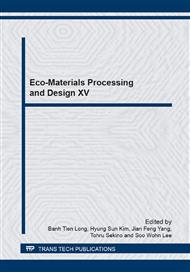p.123
p.127
p.131
p.135
p.139
p.145
p.149
p.153
p.157
Composition and Microstructure of Koryo Celadon in Korea
Abstract:
In this study, the characteristics of porcelain body, glaze and inlay were analyzed, using Koryo celadon shard of 10th-14th century. The characterization of celadon shard were investigated by Scanning electron microscopy, X-ray fluriscence, X-ray diffractometer, and Dilatometer. The characteristics of celadon shard is similar in color to gray-green with the naked eye, and the thickness of glaze layer and body is about 149.5-200μm and 4.2-8.8mm. The chemical compositions of body is SiO2 70.9-74.8wt%, Al2O3 19.4-20.5wt%, RO▪RO2(R=Ca, Mg, K) 4.0-7.0wt% and Fe2O31.3-2.7wt% in weight ratio. The high contents (12.5-24.6wt%) of calcium oxide in the glaze is considered lime type. In the chemical compositions of the white and black inlay Al2O3 is 33.2-37.1wt% and 19.7wt%, and Fe2O3 is 1.1wt% and 5.6wt% in weight ratio, respectively. The density of black inlay is higher than that of white inlay, and firing temperature for celadon may be about 1250°C.
Info:
Periodical:
Pages:
139-142
Citation:
Online since:
October 2014
Authors:
Keywords:
Price:
Сopyright:
© 2015 Trans Tech Publications Ltd. All Rights Reserved
Share:
Citation:


